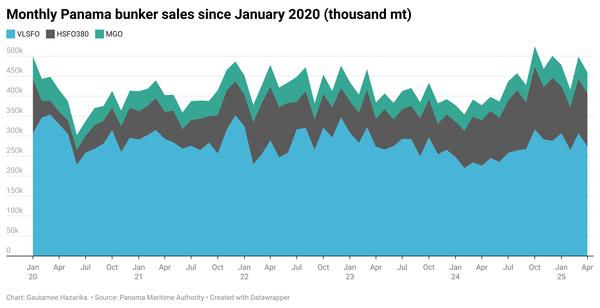Americas Market Update 16 May 2025
Bunker fuel prices have rebounded across the Americas, and the US-China tariff pause is poised to push freight rates higher.
 IMAGE: A truck driving across an intermodal shipping yard in the Port of Los Angeles, California. Getty Images
IMAGE: A truck driving across an intermodal shipping yard in the Port of Los Angeles, California. Getty Images
Changes on the day to 08.00 CDT (13.00 GMT) today:
- VLSFO prices up in New York ($16/mt), Los Angeles and Balboa ($13/mt), Zona Comun ($9/mt) and Houston ($8/mt)
- LSMGO prices up in Los Angeles ($32/mt), New York ($20/mt), Balboa ($17/mt) and Houston ($16/mt)
- HSFO prices up in Los Angeles ($13/mt), Houston ($12/mt), New York ($11/mt) and Balboa ($6/mt)
In the latest session, Los Angeles has seen the highest LSMGO price increase of $32/mt among key ports.
The West Coast port, a major entry point for Chinese container shipments into the US, was among the hardest hit by the US-China tariff escalation, recording record-low container volumes and vessel calls.
Lars Jensen, chief executive of Vespucci Maritime, said, "The US-China tariff pause is set to drive freight rates up. Carriers had already announced general rate increases (GRIs) - not from foresight, but as a routine move that only sticks if market conditions support it."
Bunker fuel availability in Los Angeles remains good, with suppliers recommending lead times of less than a week.
New York has recorded the biggest price increase for VLSFO. Its benchmark has surged to a $30/mt premium over Houston's, up from a slim $3/mt premium three months ago.
Availability across all grades remains okay in New York, with suppliers recommending lead times of 3-5 days, down from last week’s 5-7 days
Brent
The front-month ICE Brent contract has gained $0.5/bbl on the day, to trade at $64.93/bbl at 08.00 CDT (13.00 GMT).
Upward pressure:
Brent's price has gained upward momentum as some concerns about the weakness in the US economy have eased.
The US inflation rate, based on the Consumer Price Index (CPI), increased to 2.3% last month year-on-year, down from the 2.4% growth seen in March, according to the US Bureau of Labor Statistics (BLS).
The data has left room for interest rate cuts by the US Federal Reserve (Fed) this year, according to analysts. “The market isn’t leaning aggressively into [interest rate] cuts yet, but the door is clearly open,” SPI Asset Management managing partner Stephen Innes noted.
Lower interest rates in the US can boost demand, making dollar-denominated commodities like oil cheaper for holders of other currencies.
Besides, the US dollar has weakened over the past day, providing some support to Brent’s price. “The dollar kicked off the week with a bounce… but the momentum didn’t last,” Innes added.
A weaker greenback can make commodities like oil more affordable for non-dollar holders, ultimately boosting oil demand in the global market.
Downward pressure:
Brent’s price gains have been capped following US President Donald Trump's remarks on the US-Iran nuclear talks. Trump said on Thursday that Washington and Iran were very close to signing an agreement to halt the latter’s nuclear activities.
Tehran has “sort of” agreed to the terms, Trump said during the press brief on Thursday. “We're in very serious negotiations with Iran for long-term peace.”
If finalised, the deal could see the US lifting sanctions on Iranian oil. The move could add more Iranian crude to an already saturated global oil market and push prices lower, according to market analysts.
The weekly official US oil stocks figure from the US Energy Information Administration (EIA) showed an increase of 3.5 million bbls in commercial crude stocks, to touch 442 million bbls for the week ending 9 May.
“Oil prices did get a little pressure with a surprise build in crude oil inventories as reported by the Energy Information Administration (EIA),” Price Futures Group’s senior market analyst Phil Flynn said.
By Gautamee Hazarika and Aparupa Mazumder
Please get in touch with comments or additional info to news@engine.online

Contact our Experts
With 50+ traders in 12 offices around the world, our team is available 24/7 to support you in your energy procurement needs.




